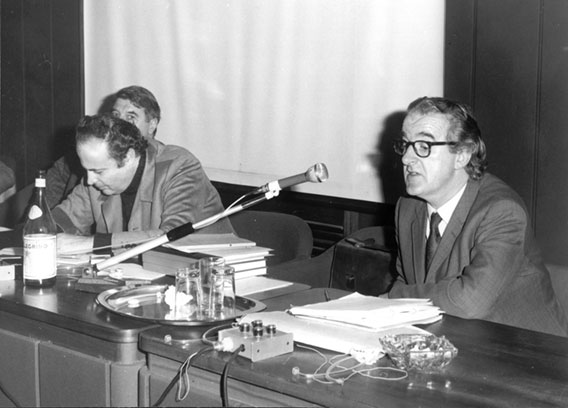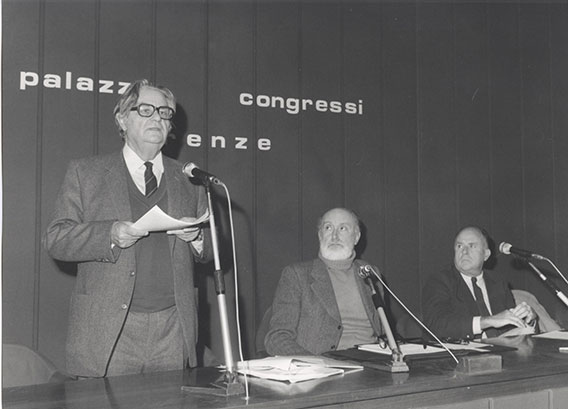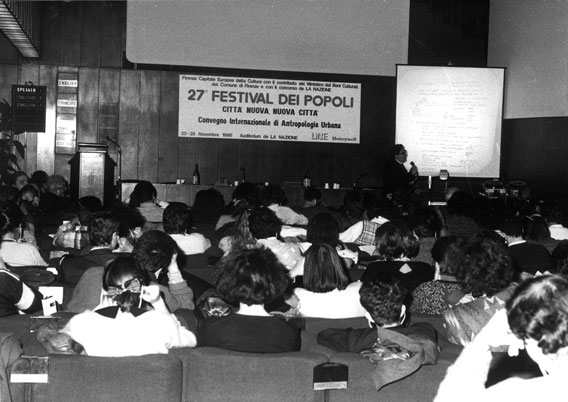From its very beginning, the Festival dei Popoli has acquired a reputation for being an event of international significance, garnering the attention of filmmakers and production companies worldwide. Year after year, films screened at the festival added up to a one of a kind collection that formed the nucleus of our film library (338 films on 35mm and 16mm) and audiovisual library that continues to grow today (over 25,000 tapes and DVDs). Copies come with print and photographic material. Thanks to this patrimony – unique in kind, quality and quantity – the Institute’s year-round activities branched out into a series of local, national and international initiatives (such as the US edition of the festival held from 2008 to 2010 at the Anthology Film Archives in New York).

Tullio Seppilli (Festival dei Popoli), James D. Halloran
(Centre for Mass Communication Research, University of Leicester)
The total variety of films in the archive reflects the evolution of documentary film over the last 60 years, in content, style and language. If the dominant profile of documentaries is drawn from anthropology and sociology, the archive covers every imaginable aspect of human experience: contemporary history, contemporary politics, fashion, society, information, architecture, contemporary art, music, dance, theatre, reflections on means of communication, cinema itself. Among the filmmakers whose works are in our archive, we would like to remember Jean Rouch, Frederick Wiseman, Johan van der Keuken, D. A. Pennebaker, Amos Gitai, Werner Herzog, Abbas Kiarostami, Alexander Sokurov, Nagisa Oshima, Ken Loach, Vittorio De Seta, Ermanno Olmi, Joris Ivens, Jørgen Leth, Agnès Varda, Ian Dunlop, Dennis O'Rourke, Sergej Dvortsevoj, Lech Kowalski, Victor Kossakowski, Ulrich Seidl, Claire Simon, Thomas Heise, Peter Mettler, Andrés Di Tella, Marcel Łoziński, Paweł Łoziński, Vincent Dieutre, Jos de Putter, Andrés Di Tella, Mary Jimenez, Wojciech Staroń, Danielle Arbid, Sergio Oksman, Kazuhiro Soda, as well as young filmmakers whose work has become a more consistent presence over the years.

at the 13rd International Conference on Ethnographic and Sociological Film
In addition to the audiovisual archive, there is a print archive containing literature of various stripes: magazines, books, articles, reviews, interviews, press books, photographs, synopses, data sheets, biographies of filmmakers. Over time, a library was built that contains roughly 1,700 titles, including books and magazines dedicated to documentary film and cinema (essays, theory, monographs, schools and trends, etc.) in Italian and other languages, primarily English, French and German. Magazines include: “Immagine e pubblico”, “Cinema cubano”, “Primi piani”, “Film Review”, “Sequenze”, “Altro Cinema”, “Griffithiana”, “Rassegna film”, “La revue du cinéma”, “Cinema sovietico”, “Cinéaste”, “Medium”, “Copie zero”, “Nuovo cinema europeo”, “Films and Filming”, “Dox”, “Tam tam video news”, “Movies Pictures”, “Cinema & Video International”, “Cinema”, “Bianco e Nero”, “Cinema nuovo”, “Film Selezione”, “Film Quarterly”, “Cineforum”, “Il fotogramma”, “Cinema società”, “Cinéma”, “Film cronache”, “Nostro cinema”, “Real Screen”; “Ecrans d’Afrique”, “Cinema e Media”, “International Documentary”, “Film Doc”, “Independent”, “Film Fest”, “Moving Pictures”, “Documentary Box”, “Cineteca Nazionale”, “Square”, “Carte di cinema”, “Seminci”, “Dea”, “Impact”, “Filmaker”, “Screen”, “Pictures Berlinale”, “Ecran”, “Cinema documentario”, “Kino”, “Il cineamatore”, “Cinequanon”, “La linea dell’occhio”, “Time and Tide”, “CNC Info”, “Cinema Sud”, “Cinema du Réel”.

By staying in touch with the major film entities and events across the globe (festivals, screenings, production companies, film commissions, etc.), we have accumulated a wealth of catalogues (6,000 approx.) covering a wide swath of film festival activity worldwide, from the mid-20th century to the present. Furthermore, the archive conserves audio-recordings of the most important debates and meetings that have taken place at the festival since 1959.
